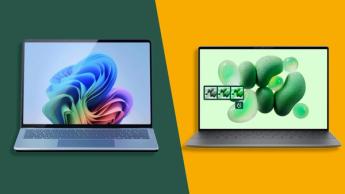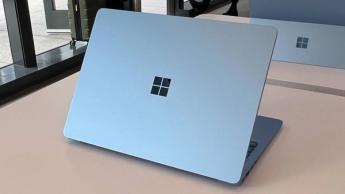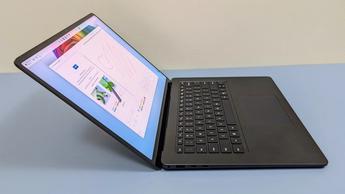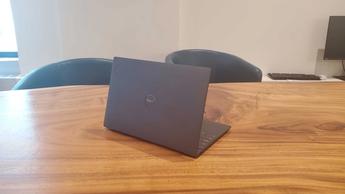Microsoft Surface Laptop 7 vs. Dell XPS 13 (2024): Welcher Laptop bietet bessere Produktivität und Leistung?
Vergleich KI-gestützter Ultrabooks: Microsoft Surface Laptop 7 und Dell XPS 13

- Microsoft Surface Laptop 7 vs. Dell XPS 13 (2024): Preisvergleich
- Microsoft Surface Laptop 7 vs. Dell XPS 13 (2024): Designvergleich
- Microsoft Surface Laptop 7 vs. Dell XPS 13 (2024): Funktionsvergleich
- Microsoft Surface Laptop 7 vs. Dell XPS 13 (2024): Leistungsvergleich
- Welcher Ultrabook passt am besten zu Ihnen
Das Microsoft Surface Laptop 7 and Dell XPS 13 (2024) cover a lot of the same ground. They’re among the best laptops out there for someone who wants that lightweight but robust and powerful experience pioneered by Apple’s MacBook line while staying within the Windows ecosystem.
They’re also among the best Windows laptops, partially thanks to using an ARM-based CPU. Specifically, the Qualcomm Snapdragon X Elite helps keep performance snappy, as long as you’re not gaming, not to mention runs efficiently enough to offer pretty remarkable battery life. They even have the same neural processing unit (NPU) for AI handling. And, of course, they’re both fairly portable as well.
The differences between the Microsoft Surface Laptop 7 and Dell XPS 13 (2024) are still notable as they come with different displays, which can affect overall performance. An OLED display is more demanding than a more basic screen, after all. They’re more pronounced on the design side of things as the port selections are different and the Dell takes a unique approach to its toolbar and trackpad. On top of that, the Microsoft Surface Laptop 7 is cheaper, whether you compare the base or maxed out configurations.
With that in mind, let’s take a deeper dive comparing these two Ultrabooks to see which one best meets your needs. After all, there’s usually no one-size-fits-all with laptops.
Microsoft Surface Laptop 7 vs. Dell XPS 13 (2024): Preisvergleich

The Microsoft Surface Laptop 7 is the cheaper option, though it’s not a huge difference until you start upgrading. The base configuration of the Surface Laptop 7 has an MSRP of $999.99 / £1,049.99 / AU$1,899. This laptop comes with 16GB of RAM and a 256GB SSD. It does come with a slightly weaker 10-core Qualcomm Snapdragon X Plus CPU, while all the other configurations across both laptops come with the 12-core X Elite version.
Going up in price with the Surface Laptop 7 just increases the RAM and/or storage space. The unit used for the review I’ve linked to has 32GB of RAM and 1TB of solid state storage and lists for $1,599.99 / £1,449 incl. VAT / AU$3,399.
The Dell XPS 13 (2024) starts with an almost comparable $1,099.99 / £1,099 including VAT / AU$2,098.80 price tag for the base configuration, which has 16GB RAM and 512GB SSD.
Of course, it comes with the more powerful Qualcomm Snapdragon X Elite CPU. But it has a slightly lower resolution display at 1920 x 1200p, compared to the Surface Laptop 7’s 2304x1536p resolution. However, the maxed out configuration is much more expensive at $2,499.99 / £1,823.99 including VAT / AU$3,999.60, which not only gives you 64GB of RAM and 2TB of storage, but an OLED display with a 2880 x 1800p resolution. It’s a very nice but expensive upgrade.
Microsoft Surface Laptop 7 vs. Dell XPS 13 (2024): Designvergleich

Sowohl das Microsoft Surface Laptop 7 als auch das Dell XPS 13 (2024) sind ultraleichte Laptops, die für Nutzer konzipiert sind, die Mobilität priorisieren. Tests beschreiben diese Modelle häufig als elegant, leicht und einfach zu transportieren. Das Microsoft Surface Laptop 7 wiegt etwa 1,34 kg (2,96 Pfund) und misst circa 30,1 x 22,0 x 1,76 cm, während das Dell XPS 13 mit 1,18 kg (2,6 Pfund) etwas leichter ist und die Maße 29,5 x 19,9 x 1,47 cm aufweisen. Insgesamt ist der Größenunterschied minimal.
Was die Displayqualität betrifft, bietet das Microsoft Surface Laptop 7 einen hochauflösenden Bildschirm mit 2304 x 1536 Pixel bei 120 Hz Bildwiederholrate und einem 3:2-Format, was es ideal für Produktivität macht. Im Vergleich dazu verfügt das Dell XPS 13 über ein 1920 x 1200 Pixel-Display bei 60 Hz und ein 16:10-Format. Beide Laptops unterstützen HDR, und die OLED-Option, die bei einigen Modellen verfügbar ist, bietet einen satteren Kontrast und eine 3K-Auflösung (2880 x 1800 Pixel), was das visuelle Erlebnis verbessert.
Touch-Funktionalität ist bei beiden Geräten vorhanden, was die Navigation und kreative Tätigkeiten erleichtert.
Das Tastatur- und Touchpad-Erlebnis variiert zwischen den Modellen. Das Surface Laptop 7 besitzt eine reaktionsschnelle Tastatur, wobei das Touchpad aufgrund seiner Empfindlichkeit eventuell eine Eingewöhnungszeit erfordert. Das Dell XPS 13 hat eine Tastatur, die randübergreifend gestaltet ist, um ein kompaktes Design zu ermöglichen, und verfügt über eine Haptik-Leiste, bei der ein Druck oberhalb der Tastatur als Klick registriert wird. Das Touchpad ist in das Gehäuse integriert und reagiert auf Druck und Haptik, was manchen Nutzern zusagen könnte, aber eine Lernkurve mit sich bringen kann.
Die Anschlussmöglichkeiten sind bei beiden Laptops etwas eingeschränkt. Das Surface Laptop 7 bietet zwei USB-C-Anschlüsse, einen normalen USB-Anschluss, einen 3,5-mm-Kopfhöreranschluss und einen microSD-Kartenleser, jedoch keine Ethernet- oder HDMI-Anschlüsse. Das Dell XPS 13 verfügt über zwei USB-C-Anschlüsse mit Thunderbolt 4-Unterstützung und keine weiteren Anschlüsse, einschließlich eines Audioanschlusses, was einen minimalistischen Ansatz widerspiegelt.
Insgesamt sind diese Ultrabooks für Nutzer konzipiert, die Mobilität, hochwertige Displays und moderne Anschlussmöglichkeiten suchen. Die Entscheidung zwischen ihnen hängt von den Präferenzen bezüglich Displayqualität, Tastaturlayout und Anschlussvielfalt ab.
Microsoft Surface Laptop 7 vs. Dell XPS 13 (2024): Funktionsvergleich

In terms of features, the Microsoft Surface Laptop 7 and Dell XPS 13 (2024) are essentially identical, particularly in the way that they approach AI. Both have the Windows Copilot key to call up Windows’ new AI buddy and both have the same functionality within that app. Both laptops include the other AI apps like CoCreator and Image Creator. And both work similarly.
That’s probably helped by the fact that both laptops use the same neural processing unit or NPU, the Qualcomm Hexagon, which has 45 TOPS of AI performance.
Even connectivity like Bluetooth 5.4 and Wi-Fi 7 support are the same across both laptops. If you’re choosing between these two laptops, feature set is not going to be the deciding factor.
Microsoft Surface Laptop 7 vs. Dell XPS 13 (2024): Leistungsvergleich

Beim Vergleich dieser beiden Laptops ist ihre Leistung ziemlich ähnlich. Beide schneiden in unseren Benchmark-Tests gut ab, wobei es je nach spezifischem Test leichte Unterschiede gibt. Das Dell XPS 13 (2024) ist tendenziell etwas schneller beim Kopieren von Dateien oder beim Kodieren von Videos. Insgesamt bieten beide eine schnelle und reaktionsfähige Leistung für alltägliche Aufgaben, wobei keiner von beiden für anspruchsvolles Gaming oder grafikintensive Arbeiten geeignet ist.
Was die Klangqualität betrifft, liefert das Microsoft Surface Laptop 7 beeindruckenden Sound für ein Gerät seiner Größe, auch wenn es im Bassbereich etwas schwach ist – was bei kompakten Laptops üblich ist. Das Dell XPS 13 (2024) bietet hingegen ein immersiveres Klangerlebnis mit vier Lautsprechern und Unterstützung für räumlichen Ton, wodurch es die bessere Wahl für Medien und Unterhaltung ist.
Die Akkulaufzeit ist ein weiterer Pluspunkt. Das Surface Laptop 7 hält bis zu 15 Stunden mit einer einzigen Ladung durch, was vor einigen Jahren noch bemerkenswert war. Das Dell XPS 13 (2024) übertrifft dies und erreicht in unseren Tests fast 19,5 Stunden Akkulaufzeit, was es zu einer ausgezeichneten Wahl für lange Tage unterwegs macht.
Welcher Ultrabook passt am besten zu Ihnen
Nachdem Sie diese beiden Laptops geprüft haben, sind beide eine starke Option, die es wert sind, in Betracht gezogen zu werden. Das Microsoft Surface Laptop 7 ist etwas günstiger und bietet einen besseren Bildschirm, wenn Sie kein OLED-Display benötigen. Es verfügt außerdem über mehr Anschlüsse und ist insgesamt eine traditionellere Wahl, die in verschiedenen Farben erhältlich ist.
Der Dell XPS 13 (2024) zeichnet sich durch sein innovatives Design aus, das viele als die Zukunft der Laptops ansehen. Sein Touchbar und Touchpad sind haptisch aktivierte Flächen anstelle von physischen Tasten, und es gibt nur wenige Anschlüsse – keinen Kopfhöreranschluss, sodass Bluetooth-Kopfhörer erforderlich sind. Es besteht auch die Möglichkeit, auf ein OLED-Display aufzurüsten, was den Bildschirm lebendiger machen kann. Während einige Nutzer diese hochmodernen Funktionen schätzen mögen, könnten andere sie als weniger praktisch empfinden. Letztlich bieten beide Laptops je nach Prioritäten überzeugende Funktionen.
